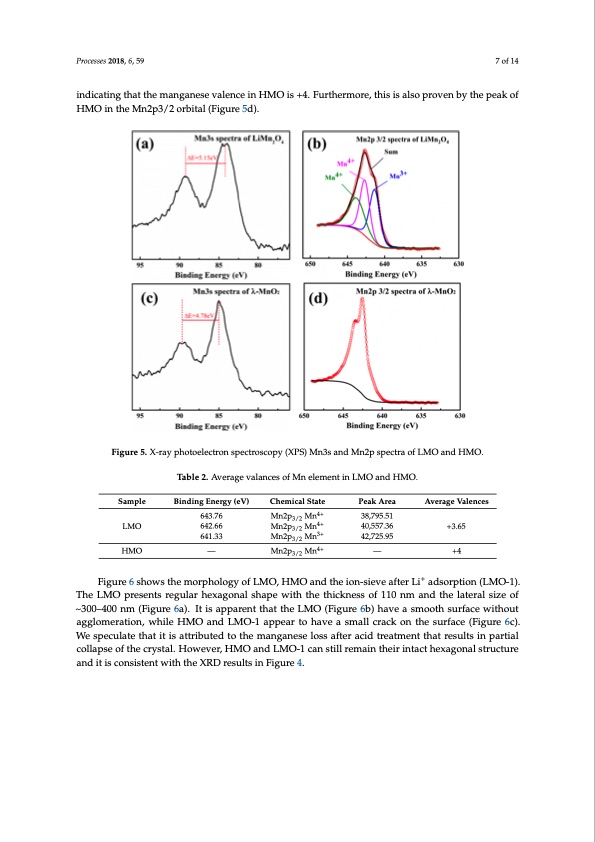
PDF Publication Title:
Text from PDF Page: 007
Processes 2018, 6, 59 7 of 14 indicating that the manganese valence in HMO is +4. Furthermore, this is also proven by the peak of HMO in the Mn2p3/2 orbital (Figure 5d). Processes 2018, 6, x FOR PEER REVIEW 7 of 14 Figure 5. X-ray photoelectron spectroscopy (XPS) Mn3s and Mn2p spectra of LMO and HMO. Figure 5. X-ray photoelectron spectroscopy (XPS) Mn3s and Mn2p spectra of LMO and HMO. Sample Sample LMO LMO HMO HMO Binding Energy (eV) Chemical State Chemical Stat4e+ Mn2p3/2 Mn Peak Area Average Valences Average Valences +3.65 +3.65 +4 Table 2. Average valances of Mn element in LMO and HMO. Table 2. Average valances of Mn element in LMO and HMO. Binding Energy (eV) Peak Area 643.76 664432.7.66 4+4+ Mnn22pp3/2Mnn 38,795.51 40,55378.,73965.51 642.66 4+ Mn2p3/32/2 Mn 40,557.36 641.33 Mn2p Mn3+ 3/2 4+ 42,725.95 641.33 42,725.95 — Mn2p3/2 Mn — +4 3/2 Mn2p Mn 3+ — Mn2p3/2 Mn4+ — Figure 6 shows the morphology of LMO, HMO and the ion-sieve after Li+ adsorption (LMO-1). + The LFiMguOrep6resheonwtssrethgeulmarohrpexhaoglognyalosfhLaMpeOw, iHthMthOeathnidckthnesisono-fs1ie1v0enamftaenr dLithaedlastoerrpatlisoinze(LoMf ~O30-10)–. T4h0e0LnMmO(Fpirgeusreent6sar)e.gIutlaisrahpexpagreontalthsahtaptheewLitMhOthe(Ftihgiuckrene6sbs)ohfa1v1e0anmsmaonodththesulraftaecrealwsiztheoouft ~a3g0g0l–o4m0e0rnatmion(F,iwguhrile6HaM).OItaisndapLpMarOen-1tathpapteathretoLhMaOve(aFisgmuarell6cbra)chkaovnetahsemsuoroftahcesu(Frifgaucerew6ict)h.oWute asgpgelcoumlaeteratihoant,iwthisileatHtriMbuOteadndtoLtMheOm-1aanpgpaneaesretolohsasvaeftaersmacaildlctraeacktmoenthtehasturfeascuelt(sFignuprear6tica)l. Wcoellsapesceuolaftehethcartysitaisl.aHttorwibeuvterd,HtoMthOeamnadnLgManOes-1ecloasnssatifltlereamciadintrtehaetimrienntatctthhatexraesguolntsalinstrpuacrttuiarel caonldlapitsiesocofnthseiscternytstwali.thHtohweeXvReDr,HreMsuOltsaindFLigMuOre-14.canstillremaintheirintacthexagonalstructure and it is consistent with the XRD results in Figure 4.PDF Image | Sieves for Highly Selective Li Adsorption

PDF Search Title:
Sieves for Highly Selective Li AdsorptionOriginal File Name Searched:
processes-06-00059-v2.pdfDIY PDF Search: Google It | Yahoo | Bing
Product and Development Focus for Infinity Turbine
ORC Waste Heat Turbine and ORC System Build Plans: All turbine plans are $10,000 each. This allows you to build a system and then consider licensing for production after you have completed and tested a unit.Redox Flow Battery Technology: With the advent of the new USA tax credits for producing and selling batteries ($35/kW) we are focussing on a simple flow battery using shipping containers as the modular electrolyte storage units with tax credits up to $140,000 per system. Our main focus is on the salt battery. This battery can be used for both thermal and electrical storage applications. We call it the Cogeneration Battery or Cogen Battery. One project is converting salt (brine) based water conditioners to simultaneously produce power. In addition, there are many opportunities to extract Lithium from brine (salt lakes, groundwater, and producer water).Salt water or brine are huge sources for lithium. Most of the worlds lithium is acquired from a brine source. It's even in seawater in a low concentration. Brine is also a byproduct of huge powerplants, which can now use that as an electrolyte and a huge flow battery (which allows storage at the source).We welcome any business and equipment inquiries, as well as licensing our turbines for manufacturing.| CONTACT TEL: 608-238-6001 Email: greg@infinityturbine.com | RSS | AMP |